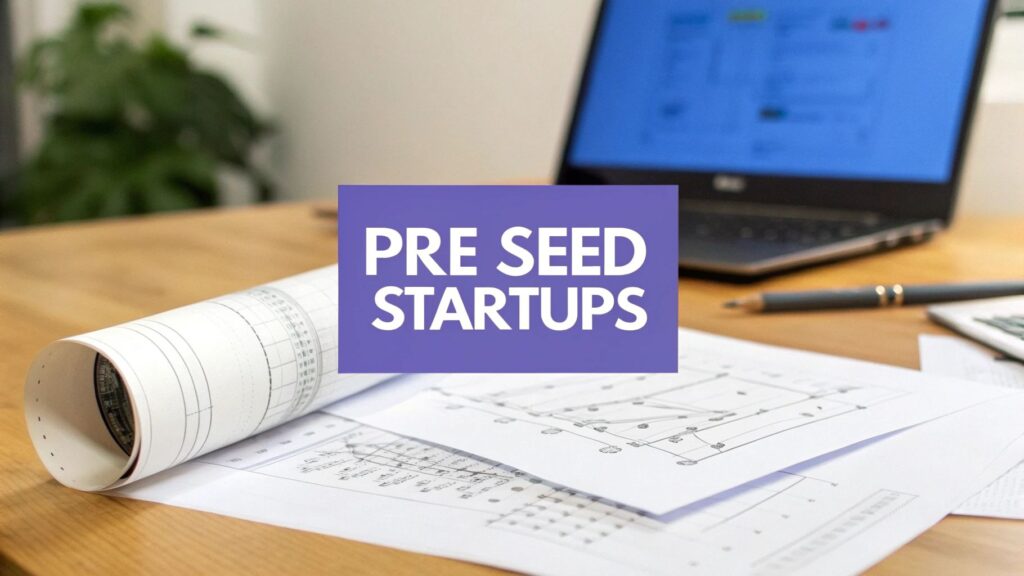A Guide to Pre Seed Startups for Agencies

- Understanding the Pre Seed Startup Landscape
- Navigating the World of Pre-Seed Funding
- Why Pre-Seed Startups Are a Hidden Opportunity
- How to Spot High-Potential Pre-Seed Startups
- Where Are Pre-Seed Investors Placing Their Bets?
- Crafting an Outreach Strategy That Founders Welcome
- Common Questions, Answered
A pre seed startup is a company in its absolute infancy. We're talking about the very beginning—often, it’s just a founder with a solid idea, a compelling pitch deck, and a whole lot of drive. Think of it like an architect's blueprint for a skyscraper. The vision is all there on paper, but not a single beam has been put in place. The main focus here isn't about finding product-market fit yet; it's about confirming the problem-solution fit. For example, Dropbox's famous MVP wasn't a product but a simple explainer video that demonstrated the file-syncing concept. The overwhelming number of sign-ups validated their solution before they'd written most of the code.
Understanding the Pre Seed Startup Landscape
Every startup goes through a series of growth stages, each with its own set of goals and hurdles. The pre seed stage is ground zero. It’s that foundational moment when a raw idea gets put to the test to see if it even has legs. The "company" at this point might be just a couple of founders hashing things out in a coffee shop, running on fumes, personal savings, and an unwavering belief in their concept.
Their mission isn’t to chase revenue or build a massive team. It’s all about answering the most basic, crucial questions: Is the problem we think we're solving a real problem for people? And is our proposed solution something they'd actually want? This is the gritty, formative period of intense research, customer interviews, and cobbling together a very basic prototype or Minimum Viable Product (MVP).
From Blueprint to Building Blocks
What truly defines pre seed startups is their obsession with validation, not execution. While a more mature company is stressing over customer acquisition costs and monthly recurring revenue, a pre seed founder is laser-focused on getting feedback from potential users and sharpening their core value proposition. For instance, the founders of Airbnb initially validated their idea by renting out air mattresses in their own apartment to conference attendees, a low-cost experiment that proved people were willing to stay in a stranger's home.
This infographic does a great job of showing where this "blueprint" phase fits into the bigger startup picture.

As the image shows, everything begins with a plan before the real building starts. That's the heart of the pre seed phase.
It’s so important to distinguish this stage from the more formal funding rounds like Seed or Series A. To put it into perspective, here’s a quick breakdown of how these early stages compare.
Startup Funding Stages at a Glance
| Stage | Primary Goal | Typical Team Size | Product Status |
|---|---|---|---|
| Pre Seed | Validate the problem-solution fit | 1-3 founders | Idea, prototype, or early MVP |
| Seed | Achieve initial product-market fit | 3-15 employees | Working MVP with early users |
| Series A | Scale the business model and grow | 15-50+ employees | Proven product with a growing user base |
This table makes it clear that by the time a startup hits the Seed or Series A rounds, they already have a tangible product, some early traction, and a clearer idea of how they'll make money.
Pre seed startups, on the other hand, are running on pure potential. Their value isn't in what they’ve already built, but in what they could build. To get a feel for what this looks like in the real world, you can explore a startup funding database to see which companies are navigating this delicate first step.
At its core, the pre seed stage is about one thing: de-risking the idea. Founders have to prove to themselves—and to their very first potential investors—that their core hypothesis holds water and is worth that first real check.
This intense focus on laying the groundwork is precisely why these budding companies offer such a massive opportunity for agencies. If you get in the door this early, you're not just a vendor; you become a foundational partner. You get to help shape the brand and strategy from day one and ride the wave of growth with a potential titan of industry.
Navigating the World of Pre-Seed Funding
Landing that first check for a pre-seed startup is a make-or-break moment. At this stage, there are no complex financial models or detailed revenue projections to show off—because they simply don't exist yet. Founders are selling a raw vision. The earliest investors aren't just betting on an idea; they're betting on the person behind it. A prime example is when Y Combinator funded a company called "Kiko" largely based on the strength of its founders. Kiko failed, but those same founders later created Twitch, which sold to Amazon for nearly $1 billion. This illustrates the investor focus on founder quality over the initial idea.
The money here comes from a tight-knit circle. These are the first believers, the ones willing to take a huge leap of faith on something that's still mostly a concept on a napkin.
Who Writes the First Checks
The financial lifeblood for pre-seed startups comes from people who are comfortable with the high-risk, high-reward nature of the game. The most common funders you'll see are:
- Friends and Family: This is almost always the first stop. These investments are built on trust and a personal relationship with the founder, not a business plan.
- Angel Investors: These are successful, high-net-worth individuals investing their own cash. For example, Andy Bechtolsheim's initial $100,000 investment in "Googol" (before it was Google) is a legendary angel check written to two founders with a great idea but no company yet. Angel investors often bring more than just money—their mentorship and industry connections can be priceless.
- Micro-VCs: Think of these as smaller, nimbler venture capital firms. They focus squarely on early-stage deals, writing smaller checks than the big players but making decisions much faster. Firms like Precursor Ventures and Notation Capital specialize in this pre-seed space.
These investors know they're backing a blueprint, not a finished building. Their decision comes down to the founder's passion, their unique insight into a problem, and the sheer size of the opportunity they're chasing. A spreadsheet rarely seals the deal.
An investor at the pre-seed stage is fundamentally buying into a story. They need to believe in the founder’s ability to navigate uncertainty, pivot when necessary, and build a team capable of turning that story into reality.
This initial funding is absolutely critical, but getting it is incredibly hard. The competition is fierce, with thousands of founders all fighting for the attention of a very small pool of investors. The hard truth is that most ideas, no matter how brilliant they seem, will never get this first round of cash.
The Odds of Securing Capital
The path to funding is a gauntlet, and the numbers don't lie. According to the Angel Capital Association, only about 3% of pre-seed applications actually end up getting funded. That’s a brutal statistic, and it highlights the immense pressure founders are under. If you want to dive deeper, you can discover more insights about startup funding probability on Equidam.com.
This financial reality shapes a pre-seed founder's entire mindset. They live and breathe their limited runway, knowing every single dollar has to push them toward a critical milestone. For an agency wanting to work with them, understanding this pressure is everything. It drives their spending, their sense of urgency, and what they absolutely need to achieve to survive and earn that next round of investment.
Why Pre-Seed Startups Are a Hidden Opportunity
Most agencies are busy chasing established companies with fat marketing budgets. It's the safe play. But the real gold rush? It's happening in a place most agencies overlook: pre-seed startups.
Focusing on these early-stage ventures isn't just another tactic; it's a strategic move that can completely reshape an agency's future. It’s about playing the long game.
Think of it like being the architect who helps draw up the final blueprints for a skyscraper. When you partner with a startup this early, you're not just another vendor they hired. You become a foundational partner. The branding you create, the messaging you shape, the go-to-market strategy you build—that’s the bedrock the entire company will be built on.
This level of integration is almost impossible to find with bigger clients who are already set in their ways, bogged down by legacy systems and internal politics.
Becoming an Indispensable Partner
With a pre-seed startup, your work has a massive, tangible impact. A killer brand identity or a smart launch plan isn't just another deliverable; it might be the very thing that convinces an investor to write that first crucial check. For example, an agency that helps a FinTech startup create a compelling one-page website explaining their complex idea can directly influence whether an angel investor takes the first meeting.
Suddenly, your agency isn't just a line item on a budget. You’re indispensable.
And as they grow, you grow right alongside them. That small initial project can easily blossom into a long-term, high-value retainer. After all, the agency that helps a founder get funded is the first one they call when the money hits the bank. The lifetime value of that relationship can dwarf what you'd get from a standard one-off project.
By getting in on the ground floor, your agency moves from being a service provider to a strategic asset. You become part of the startup's origin story, creating a powerful and lasting relationship.
Exploring Equity and Long-Term Gains
Here’s where it gets really interesting: the potential for equity. Pre-seed startups are almost always tight on cash, but they have plenty of equity to offer. For an agency willing to bet on a founder's vision, swapping some of your services for a slice of the company can lead to a monumental payoff.
Picture this: your agency builds the initial brand strategy for a tiny tech startup. In exchange for a lower fee, you take a small piece of equity. A few years down the line, that company explodes and becomes a unicorn. Your initial work has now generated a return that traditional client fees could never even touch. A well-known example is the graffiti artist David Choe, who opted for stock instead of cash to paint Facebook's first office. That decision famously made him a multi-millionaire.
This model perfectly aligns everyone's goals. The startup wins, you win. It's a true partnership.
Working with pre-seed startups definitely requires a different mindset. You have to shift your focus from chasing short-term cash to building long-term value. But by finding the right founders and embedding your agency into their journey, you can build the kind of deeply loyal, incredibly profitable partnerships that will define your own success for years to come.
How to Spot High-Potential Pre-Seed Startups

Trying to find a future unicorn among thousands of pre-seed startups can feel like searching for a needle in a haystack. There’s no revenue to analyze, no established product to test, and no traditional metrics to fall back on. So, what do you look for?
The key is to focus on the raw materials—the deeper, more qualitative signals that hint at a solid foundation and a massive upside. It's less about a polished pitch deck and more about spotting founders who have that rare combination of grit, vision, and some early proof they’re onto something real. If you know what to look for, you can spot these ventures before they hit the mainstream.
Look Beyond the Idea to the Founder
An idea is just a starting point. Execution is everything. Time and time again, savvy investors bet on the founder, not the concept. Why? Because a great founder can steer a mediocre idea toward success, but a weak founder can easily run a brilliant idea into the ground.
Here’s what to look for in a founding team:
- A Track Record of Execution: Have they actually built something before? It doesn’t need to be a huge exit. Maybe it was a successful side project, a popular open-source tool, or a complex initiative they led at a previous job. This proves they can get things done.
- Deep Domain Expertise: Does the founder have a unique, hard-won insight into the problem they're solving? The best ideas often come from people who have lived and breathed the pain point they’re trying to fix. For example, the founders of Stripe, Patrick and John Collison, were developers frustrated with how difficult it was to accept payments online.
- Unwavering Resilience: The pre-seed journey is an absolute grind. You want to see founders who demonstrate tenacity and the ability to bounce back from the inevitable setbacks.
The most compelling signal a founder can send is not the perfection of their idea, but their obsessive dedication to solving a specific problem for a specific group of people.
Hunt for Early Signs of Validation
At this stage, "validation" isn't about sales figures. It’s about finding real-world evidence that people genuinely want what the startup is building. This proof can show up long before a single line of code is written or a service officially launches.
Keep an eye out for these early indicators of traction:
- A Rapidly Growing Waitlist: If hundreds or even thousands of people are willing to give up their email just to be notified of a launch, that’s a powerful sign of pent-up demand. Superhuman famously built a waitlist of over 100,000 people before it was widely available.
- A Passionate Online Community: Is there a buzzing Discord server, a lively subreddit, or an engaged social media following? A community built around the problem itself is a massive asset.
- A Simple Prototype That Solves a Real Problem: Even a clunky MVP with just a handful of die-hard users is far more valuable than a beautiful product that nobody is using.
Where to Find These Opportunities
Promising pre-seed startups aren't advertising on billboards. You have to know where to look. While networking at niche demo days and industry meetups is great, the digital world is a goldmine for discovery.
You can track new companies on databases like Crunchbase or hang out in founder-focused online forums like Indie Hackers or the Y Combinator forum. For a more structured approach, our guide on finding company information gives you a detailed playbook for uncovering these hidden gems. By mixing sharp observation with smart research, you can consistently get in front of the startups with true breakout potential.
Where Are Pre-Seed Investors Placing Their Bets?
If you want to land high-potential pre-seed clients, you need to know where the smart money is going. It's not about chasing fads; it's about understanding which sectors are genuinely ripe for a shake-up, usually thanks to new tech or a big shift in what people want. When your agency can speak the language of these high-growth verticals, you stop being just another vendor and start looking like an insider.
Think about it: investors don’t throw darts at a board. They follow clear signals. That's why industries like Artificial Intelligence, FinTech, and HealthTech are constantly buzzing with pre-seed activity. These are massive, often clunky markets just begging for a better way to do things.
A founder with a smart AI solution for untangling supply chain nightmares, for example, is solving a multi-billion dollar headache. That’s a story an early-stage investor wants to hear. Focusing your outreach on these hotbeds means you’re fishing where the fish are biting.
The Epicenters of Pre-Seed Activity
Right now, a few key sectors are absolute magnets for pre-seed capital. These aren't just trends; they represent fundamental changes in how we live, work, and interact with the world.
Here’s where you should be looking:
- Artificial Intelligence and Machine Learning: This is the big one. We're seeing AI pop up everywhere, from discovering new medicines and automating grunt work to crafting hyper-personalized marketing campaigns. According to PitchBook, AI and ML startups attracted a record $25.2 billion in venture funding in the first quarter of 2024 alone, indicating strong downstream effects for pre-seed activity.
- FinTech: The financial world is still being rebuilt. Founders are tackling everything from seamless payment systems and smarter lending platforms to personal finance tools that actually make sense. The common thread is making money simpler, fairer, and more accessible.
- HealthTech and BioTech: Technology is fundamentally changing our relationship with health. Think telehealth platforms that bring doctors to your living room, revolutionary diagnostic tools, and wellness apps that empower preventative care. Investors are backing startups that can improve lives and streamline a notoriously complex industry.
Knowing why these sectors are hot is your secret weapon. It lets you walk into a conversation with a founder and show you get it. You understand their world, their challenges, and their vision for the future.
How to Follow the Money
Investor excitement can be a moving target. The key is to watch the data and see where the momentum is building. For example, recent funding analysis shows just how fast things can change.
The Information Technology & Services sector saw its pre-seed funding double from $13.5 million in January to $27.5 million in February 2025, only to cool down the next month. At the same time, Financial Services saw steady, consistent growth, signaling strong, unwavering investor belief in that space. You can explore more details about these funding trends to get a clearer picture.
This is the kind of insight that turns your agency from a generalist into a specialist—a strategic partner who knows exactly where the action is for pre-seed startups.
Crafting an Outreach Strategy That Founders Welcome
https://www.youtube.com/embed/2d7NNAAZOpI
Let's be honest: pre seed startup founders are living in a pressure cooker. Their inboxes are a warzone of generic sales pitches, and they've developed a sixth sense for spotting a boilerplate email from a mile away. If you want to get their attention, you can't just show up and sell. You have to give first.
This "give-first" approach is all about offering real, tangible value right out of the gate, with zero strings attached. Forget leading with your credentials deck. Instead, lead with a genuinely helpful insight. This completely flips the script, turning a cold pitch into a warm introduction and building a foundation of trust before a contract is ever on the table.
The key to unlocking that first conversation is a hyper-personalized message. And I don't mean just dropping [First Name] into a template. You have to prove you’ve done the homework on their mission, their market, and the unique problems they're trying to solve.
Personalization That Actually Works
Anyone can say, "I love what you're building." That's empty. Real personalization shows you've put in the effort and actually understand their world.
- Reference Their Vision: Did they appear on a podcast or write a blog post? Mention a specific point they made. Show them you get their "why." "I heard your interview on the 'Startup Grit' podcast and your point about 'data empathy' for supply chain managers really resonated."
- Identify a Real Gap: Offer a specific, actionable observation. For example, "I saw your landing page copy is very feature-focused. A quick tweak to highlight the main user benefit could really move the needle on sign-ups."
- Provide a Micro-Solution: Don't just point out a problem; give them a small piece of the solution for free. This could be a revised headline, a quick design mock-up, or even just a link to a resource that solves their immediate hurdle. Attach a Loom video with a 60-second audit of their homepage.
This level of detail shows you see them as a unique business, not just another lead in your CRM. For a deeper dive into this, check out our guide on how to master cold email outreach. To really amp up your efforts, it's also worth exploring modern tools and AI-powered lead generation strategies to find these startups in the first place.
Structuring Proposals for a Pre-Seed Budget
Once you get to the proposal stage, you have to remember that pre-seed startups are incredibly careful with their cash. It's just a fact of life at this stage. You can discover more insights about these global venture trends on Crunchbase News.
Your proposal has to match a founder's bootstrapped budget and their long-term vision. This is all about flexibility and shared risk, not rigid, expensive retainers.
Think about offering engagement models that don't create a huge upfront financial burden. A small, paid discovery project can be a fantastic way to start, letting both of you test the waters. For example, offer a $2,500 "Brand Sprint" package to define their core messaging and visual identity, which provides immediate value and builds trust for a larger engagement later.
Another great option is a service-for-equity model. This creates a powerful alignment of interests, turning you from a vendor into a true partner in their success. When you show that you understand their financial reality and are willing to share in the risk, you're proving that you're invested in their journey, not just their next invoice.
Common Questions, Answered
Working with a pre-seed startup isn't like landing a Fortune 500 client. It's a different world with its own rules and risks. If you're thinking about jumping in, you probably have a few questions. Let's clear them up.
How Much Money Are We Really Talking About?
Forget the massive funding rounds you see in the headlines. Pre-seed is all about getting an idea off the ground, not scaling an empire.
Typically, a pre-seed round lands somewhere between $50,000 and $250,000. Of course, this number can swing a bit depending on the industry or how well-connected the founders are. This cash isn't for Super Bowl ads; it’s for the bare essentials—building a minimum viable product (MVP), doing some initial market research, and keeping the lights on.
What’s the Catch? What Are the Real Risks?
Let's be blunt: the biggest risk is that the startup will fail. It’s a harsh reality, but CB Insights reports that around 38% of startups fail because they run out of cash or fail to raise new capital. This is most acute at the pre-seed stage. Any project you're on could stop dead in its tracks, and if you took equity as part of your payment, it could end up being worth absolutely nothing.
The other major headache can be chaos. Founders are wearing a dozen hats at once, from CEO to customer support. This can lead to messy communication and unpredictable workflows. You have to go in with your eyes open and establish crystal-clear communication channels from the very beginning.
The greatest reward of partnering with a pre seed startup—becoming a foundational part of a potential success story—is directly tied to its greatest risk: the high probability of early-stage failure.
How Should We Structure the Deal?
Your standard, iron-clad agency contract won't fly here. You need to be agile and think like a partner, not just a vendor.
Try thinking about more flexible arrangements that work for both of you:
- Bite-Sized Projects: Start with small, well-defined projects. It's a great way to prove your value without forcing the startup into a massive financial commitment. An example is a two-week "Landing Page Optimization" project for a fixed fee.
- Skin in the Game: Consider a service-for-equity deal. You might lower your cash fee in exchange for a small piece of the company. It’s a gamble, but the payoff could be huge.
- Pay-for-Performance: Tie your compensation to tangible results. This could mean getting paid when they hit a certain number of sign-ups or successfully close their seed round. This is riskier but shows ultimate alignment.
These kinds of deals align your success with theirs. When they win, you win—and that’s the definition of a true partnership.
Stop chasing cold leads and start connecting with founders who have the capital to invest in growth. FundedIQ delivers a monthly, hand-curated list of recently funded startups, complete with verified decision-maker contacts and critical buying signals. Find your next great partnership.





